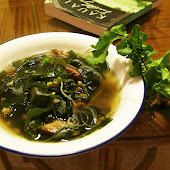Tropical Lagoon Soup,
with Seaweed and Mung Beans
with Seaweed and Mung Beans
Inspired by the smell of the Pacific and by Japanese cuisine, this light soup smells and tastes (well, almost) like the sea. On Kauai, where we are spending our vacation, black volcanic rocks jut over the clear water, the mountains and the sky of ever changing hues defy description. Alas, beauty is not enough to feed the body!
Grocery stores here bear a mark of Japanese influence: dried shiitake mushrooms, wakame seaweed and mung beans are an easy find. Mung beans are tiny dull green beans, almost as small as lentils. Japanese use them to make desserts, but to my mind a bean is a bean and belongs just as well in a soup.
Restaurants on the North Shore of Kauai close early, so I've been cooking simple dinners for us. This soup is one of them.
Grocery stores here bear a mark of Japanese influence: dried shiitake mushrooms, wakame seaweed and mung beans are an easy find. Mung beans are tiny dull green beans, almost as small as lentils. Japanese use them to make desserts, but to my mind a bean is a bean and belongs just as well in a soup.
Restaurants on the North Shore of Kauai close early, so I've been cooking simple dinners for us. This soup is one of them.
What you need:
(all measurements very approximate; use your best judgement)
6-12 medium dried shiitake mushrooms
1/4 cup dried wakame seaweed
1/2 cup dried mung beans
~2oz dry maifun rice noodles
water for desired soup consistency
salt to taste
How to do it:
Overnight:
1. Wash and boil the shiitake mushrooms for 5-10 minutes. If the mushrooms are whole, let them cool, slice and throw back into the water used for boiling. Let soak at room temperature for a day (about 10 hours is enough).
At dinner time:
2. Bring the soaked mushrooms to a boil, add salt and cook until soft (~30 min).
3. In a separate pot, gently boil mung beans in plenty of lightly salted water until ready (~20 min). When done, strain and set aside.
4. When the mushrooms are cooked through, throw in wakame seaweed and let boil gently for 3 minutes.
5. Throw in the noodles and mung beans, adding boiling water if the soup is too thick. Make sure to taste for salt and add more if necessary. Wait just until the soup begins to boil again, take off the heat, cover and let stand for 10 minutes (meifun noodles should not be boiled).
6. Enjoy and imagine that you are sitting under a palm trea with the ocean at your feet.
Notes:
Ideally, meifun noodles should be cooked separately and added individually to every bowl. This prevents the noodles from expanding too much after soaking for a day in the left-over soup. If you plan to eat all of the soup right after it is prepared, cooking the noodles right in the soup (as I have done) is fine.
When making a soup with so many ingredients that soak up water, it's good to keep a kettle of boiled water handy. Whenever the boiling beans or soup need more water, just pour in boiling water from the kettle.
(all measurements very approximate; use your best judgement)
6-12 medium dried shiitake mushrooms
1/4 cup dried wakame seaweed
1/2 cup dried mung beans
~2oz dry maifun rice noodles
water for desired soup consistency
salt to taste
How to do it:
Overnight:
1. Wash and boil the shiitake mushrooms for 5-10 minutes. If the mushrooms are whole, let them cool, slice and throw back into the water used for boiling. Let soak at room temperature for a day (about 10 hours is enough).
At dinner time:
2. Bring the soaked mushrooms to a boil, add salt and cook until soft (~30 min).
3. In a separate pot, gently boil mung beans in plenty of lightly salted water until ready (~20 min). When done, strain and set aside.
4. When the mushrooms are cooked through, throw in wakame seaweed and let boil gently for 3 minutes.
5. Throw in the noodles and mung beans, adding boiling water if the soup is too thick. Make sure to taste for salt and add more if necessary. Wait just until the soup begins to boil again, take off the heat, cover and let stand for 10 minutes (meifun noodles should not be boiled).
6. Enjoy and imagine that you are sitting under a palm trea with the ocean at your feet.
Notes:
Ideally, meifun noodles should be cooked separately and added individually to every bowl. This prevents the noodles from expanding too much after soaking for a day in the left-over soup. If you plan to eat all of the soup right after it is prepared, cooking the noodles right in the soup (as I have done) is fine.
When making a soup with so many ingredients that soak up water, it's good to keep a kettle of boiled water handy. Whenever the boiling beans or soup need more water, just pour in boiling water from the kettle.
Summary: a healthy soup recipe
blog comments powered by Disqus






